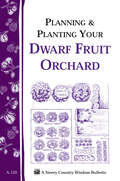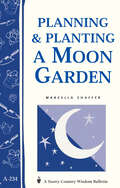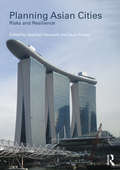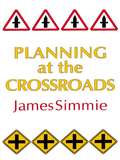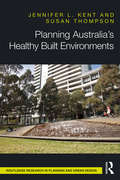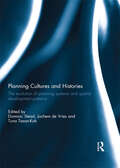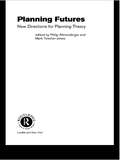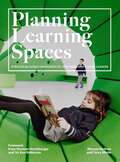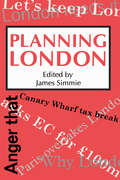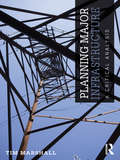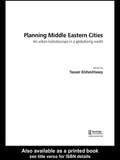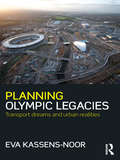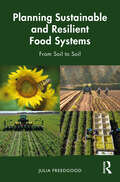- Table View
- List View
Planner's Estimating Guide: Projecting Land-Use and Facility Needs
by Arthur NelsonThe United States faces enormous changes in the next 25 years. Arthur C. (Chris) Nelson starts this book with a few projections: The population will grow by one-third to 375 million. We will need 60 million new housing units to house these people. There will be 60 percent more jobs, requiring 50 billion additional square feet of nonresidential space. The bottom line is that half of all development in 2030 will have been built since 2000. Nelson estimates the cost of new construction alone to be at least $20 trillion. This book gives planning practitioners a powerful tool to help decide where to put this new development. It does not advocate one development scenario over another, but it revolutionizes the job of estimating land-use and facility needs. Planner's Estimating Guide offers easy-to-use formulas and worksheets that are formatted in an Excel workbook on CD-ROM and carefully explained in the text. They make it easy to figure future requirements for countless scenarios. The workbook and text deal with a 20-year planning horizon for a fictitious county, but both the time projection and scale are entirely adaptable to myriad local circumstances. The program allows you to gather a first impression of future land-use needs, and revise it to reflect local limitations. For example, if the landscape in question won't support the land-use estimations, change the assumptions in the workbook to devise new estimates. The workbook shows the implications of growth based on standard assumptions; you can change the assumptions as needed to reflect local conditions — including public input — to see how outcomes change. Use the workbook as a model for testing local sensitivities with respect to land supply constraints and changes in policy assumptions. The results won't tell you what to do, but will reveal the numerical implications of different scenarios. The book is written principally for practitioners, and also for planning students as a primary or supplementary text. Used creatively, the powerful tools in Planner's Estimating Guide will help you determine the numerical implications of an almost infinite number of future circumstances that may affect your community.
Planning & Planting Your Dwarf Fruit Orchard: Storey's Country Wisdom Bulletin A-133 (Storey Country Wisdom Bulletin)
by Editors of Garden Way PublishingSince 1973, Storey's Country Wisdom Bulletins have offered practical, hands-on instructions designed to help readers master dozens of country living skills quickly and easily. There are now more than 170 titles in this series, and their remarkable popularity reflects the common desire of country and city dwellers alike to cultivate personal independence in everyday life.
Planning & Planting a Moon Garden: Storey's Country Wisdom Bulletin A-234 (Storey Country Wisdom Bulletin Ser.)
by Marcella ShafferWith today's schedules, few people are able to enjoy their gardens during prime daylight hours. But there is a way you can delight in the fragrance and beauty of flowers after dark: Plant a night-blooming garden! Also known as moon gardens, night-blooming gardens are expressly designed for evening enjoyment. <P><P>While attractive during the day, they take on a whole new look and feel at dusk, casting a magical spell. Pale-colored flowers reflect light from the setting sun and the rising moon, shining luminously and giving the garden an almost mystical glow. Fragrances seem more alluring. Silvery foliage shimmers tremulously as the evening breezes dance by. <P>An aromatic, night-blooming garden offers a peaceful and tranquil spot to rest and relax at the end of the day. It is the perfect place for a casual summer party, an evening reception, a romantic tryst, or a quiet retreat to reflect and rejuvenate the senses.
Planning Abu Dhabi: An Urban History (Planning, History and Environment Series)
by Alamira Reem Bani HashimAbu Dhabi’s urban development path contrasts sharply with its exuberant neighbour, Dubai. As Alamira Reem puts it, Abu Dhabi, capital of the United Arab Emirates since 1971, ‘has been quietly devising its own plans … to manifest its role and stature as a capital city’. Alamira Reem, a native Abu Dhabian and urban planner and researcher who has studied the emirate’s development for more than a decade, is uniquely placed to write its urban history. Following the introduction and description of Abu Dhabi’s early modern history, she focuses on three distinct periods dating from the discovery of oil in 1960, and coinciding with periods in power of the three rulers since then: Sheikh Shakhbut bin Sultan Al Nahyan (1960–1966), Sheikh Zayed bin Sultan Al Nahyan (1966–2004), and Sheikh Khalifa bin Zayed Al Nahyan (2004–). Based on archival research, key interviews and spatial mapping, she analyses the different approaches of each ruler to development; investigates the role of planning consultants, architects, developers, construction companies and government agencies; examines the emergence of comprehensive development plans and the policies underlying them; and assesses the effects of these many and varied influences on Abu Dhabi’s development. She concludes that, while much still needs to be done, Abu Dhabi’s progress towards becoming a global, sustainable city provides lessons for cities elsewhere.
Planning Asian Cities: Risks and Resilience (Planning, History and Environment Series)
by Stephen Hamnett Dean ForbesIn Planning Asian Cities: Risks and Resilience, Stephen Hamnett and Dean Forbes have brought together some of the region’s most distinguished urbanists to explore the planning history and recent development of Pacific Asia’s major cities. They show how globalization, and the competition to achieve global city status, has had a profound effect on all these cities. Tokyo is an archetypal world city. Singapore, Hong Kong and Seoul have acquired world city characteristics. Taipei and Kuala Lumpur have been at the centre of expanding economies in which nationalism and global aspirations have been intertwined and expressed in the built environment. Beijing, Hong Kong and Shanghai have played key, sometimes competing, roles in China’s rapid economic growth. Bangkok’s amenity economy is currently threatened by political instability, while Jakarta and Manila are the core city-regions of less developed countries with sluggish economies and significant unrealized potential. But how resilient are these cities to the risks that they face? How can they manage continuing pressures for development and growth while reducing their vulnerability to a range of potential crises? How well prepared are they for climate change? How can they build social capital, so important to a city’s recovery from shocks and disasters? What forms of governance and planning are appropriate for the vast mega-regions that are emerging? And, given the tradition of top-down, centralized, state-directed planning which drove the economic growth of many of these cities in the last century, what prospects are there of them becoming more inclusive and sensitive to the diverse needs of their populations and to the importance of culture, heritage and local places in creating liveable cities?
Planning At The Crossroads
by James SimmieThrough a detailed analysis of studies of the effects of planning, comparing low levels of urban containment in California with much higher levels in the UK. Some comparative insights are also drawn from the (pre-conflict) Yugoslavian planning system. The analysis shows that many of the serious criticisms of planning are valid and leads to the conclusion that some sacred cows - notably "green belts" - should be abandoned. This distinctive text is of use to students, researchers and professionals in planning, geography and urban studies.
Planning Australia’s Healthy Built Environments
by Susan Thompson Jennifer L. KentPlanning Australia’s Healthy Built Environments shines a quintessentially Australian light on the links between land use planning and human health. A burgeoning body of empirical research demonstrates the ways urban structure and governance influences human health—and Australia is playing a pivotal role in developing understandings of the relationships between health and the built environment. This book takes a retrospective look at many of the challenges faced in pushing the healthy built environment agenda forward. It provides a clear and theoretically sound framework to inform this work into the future. With an emphasis on context and the pursuit of equity, Jennifer L. Kent and Susan Thompson supply specific ways to better incorporate idiosyncrasies of place and culture into urban planning interventions for health promotion. By chronicling the ways health and the built environment scholarship and practice can work together, Planning Australia’s Healthy Built Environments enters into new theoretical and practical debates in this critically important area of research. This book will resonate with both health and built environment scholars and practitioners working to create sustainable and health-supportive urban environments.
Planning Commissioners Guide: Processes for Reasoning Together
by C Gregory Dale Benjamin A Herman Anne McBrideAcross the country, communities rely on their planning commissions for guidance. But who guides the planning commissioners? This step-by-step guidebook gets new commissioners off on the right foot and helps experienced commission members navigate their roles. The authors, all practicing planners, have worked extensively with planning commissions for decades. They have watched commissioners scramble up a steep learning curve, sit in the hot seat of controversy, and strive to make sound decisions for the places they call home. In this helpful handbook, the authors share ideas, insights, and information to help commissioners succeed. Eight detailed chapters cover everything from the nuts and bolts of development applications to the nuances of legal issues to the part commissioners play in long-range planning. Readers will learn how to prepare for their first commission meeting, review a development plan, invite productive public input, and steer clear of ethical dilemmas. Added resources include a glossary of planning terms, a list of training resources, and the American Planning Association’s Statement of Ethical Principles in Planning. For anyone serving on a planning commission, The Planning Commissioners Guide is essential reading.
Planning Cultures and Histories: The evolution of Planning Systems and Spatial Development Patterns
by Dominic Stead, Jochem de Vries and Tuna Tasan-KokThis book addresses the influences of planning cultures and histories on the temporal evolution of planning systems and spatial development. As well as providing an international comparative perspective on these issues, the contributions to the book also engage in a search for new conceptual frameworks and alternative points of view to better understand and explain these differences. The book makes three main academic contributions. First, it catalogues some of the key changes in planning systems and the impact on spatial development patterns. Second, it examines the interrelationship between planning cultures and histories from a path-dependency perspective. Third, it discusses the variations in physical development patterns resulting from different planning cultures and histories. Chapters from different parts of the European continent present evidence at different scales to illustrate these aspects. In all cases, the specific combinations of political, ideological, social, economic and technological factors are important determinants of urban and regional planning trajectories as well as spatial development patterns. This book was previously published as a special issue of European Planning Studies.
Planning Europe's Capital Cities: Aspects of Nineteenth-Century Urban Development (Planning, History and Environment Series)
by Thomas HallDuring the nineteenth century many of Europe's capital cities were subject to major expansion and improvement schemes. From Vienna's Ringstrasse to the boulevards of Paris, the townscapes which emerged still shape today's cities and are an inalienable part of European cultural heritage.In Planning Europe's Capital Cities, Thomas Hall examines the planning process in fifteen of those cities and addresses the following questions: when and why did planning begin, and what problems was it meant to solve? who developed the projects, and how, and who made the decisions? what urban ideas are expressed in the projects? what were the legal consequences of the plans, and how did they actually affect subsequent urban development in the individual cities? what similarities or differences can be identified between the various schemes? how have such schemes affected the development of urban planning in general?His detailed analysis shows us that the capital city projects of the nineteenth century were central to the evolution of modern planning and of far greater impact and importance than the urban theories and experiments of the Utopians.
Planning Futures: New Directions for Planning Theory
by Philip Allmendinger Mark Tewdwr-JonePlanning theory is currently in a confused state as a consequence of a number of changes over the last ten years in planning practice and social and economic theory. Even prior to these events, planning theory was an uncertain discipline, reflecting planning's precarious position between and resting upon a range of professional subject areas and philosophical roots. Planning Futures is an attempt to pin down the constantly evolving landscape of planning theory and to chart a path through this fast changing field.Planning Futures is an up-to-date reader on planning theory, but adds something more to the subject area than a mere textbook. The contributors have attempted to bridge theory and practice while putting forward new theoretical ideas. By drawing upon examples from planning practice and case study scenarios, the authors ensure that the work discusses planning theory within the context of present planning practice. Case studies are drawn from an international arena, from the UK, Europe, South Africa and Australia.
Planning Latin America's Capital Cities 1850-1950 (Planning, History And The Environment Ser.)
by Arturo AlmandozIn this first comprehensive work in English to describe the building of Latin America's capital cities in the postcolonial period, Arturo Almandoz and his contributors demonstrate how Europe and France in particular shaped their culture, architecture and planning until the United States began to play a part in the 1930s. The book provides a new per
Planning Law and Practice in Northern Ireland
by Stephen McKay and Michael MurrayEach of the jurisdictions within the United Kingdom is constantly refining the operational characteristics of its planning system and while there are some common practices, there are also substantive divergences. In each territory the planning template is shaped within a dynamic political and legal context and thus students and practitioners require an accessible, in-depth and up-to-date literature dealing with this matter. The multi-disciplinary contributors to this expanded Second Edition of Planning Law and Practice in Northern Ireland explore the progression of planning within the region and discuss prominent facets of contemporary development management, development plans, environmental law, property law and professional practice. Consideration is given to the consequences of Brexit for planning in Northern Ireland, devolved government institutional structures for planning, and the post-2015 emergent performance of local authorities in this arena. The book makes an important contribution to the wider literature in this field and, with its extensive citing of statutes and cases, provides an essential resource for students, planning practitioners and researchers.
Planning Learning Spaces
by Murray Hudson“A welcome and timely addition to the subject of school design at a time of great change.†—Professor Alan Jones, President of the Royal Institute of British Architects “Comprehensive but also very practical approach.†—Andreas Schleicher, Director for the Directorate of Education and Skills in Paris, France“Any community building a new school should read this book.†—Michael B. Horn, Clayton Christensen Institute for Disruptive Innovation in Boston, USA “Builds a bridge from the simple to the extraordinary... awash in opportunity and inspiration.†—Professor Stephen Heppell, Chair in Learning Innovation at the Universidad Camilo Jose Cela in Madrid, Spain Can school design help us to realize a new vision for education that equips young people for life in a fast-changing world? This is the big question at the heart of Planning Learning Spaces, a new guide for anyone involved in the planning and design of learning environments. Murray Hudson and Terry White have brought together educators and innovative school architects to pool their collective expertise and inspire the design of more intelligent learning spaces. The authors prompt readers to question common assumptions about how schools should look and how children should be educated: •Why have so many schools changed relatively little in more than a century? •What form should a school library take in the Internet age? •Do classrooms really have to be square?The book also tackles vital elements of learning space design such as the right lighting, heating and acoustics, and explores the key role of furniture, fixtures, and fittings.With contributions from leading professionals around the world, including Herman Hertzberger and Sir Ken Robinson, Planning Learning Spaces is an invaluable resource for architects, interior designers, and educators hoping that their project will make a genuine difference. Highly recommended reading for anyone involved with the process of building or updating an educational space.
Planning Learning Spaces: A Practical Guide for Architects, Designers, School Leaders
by Terry White Murray Hudson Murray Hudson, White“A welcome and timely addition to the subject of school design at a time of great change.”—Professor Alan Jones, President of the Royal Institute of British Architects “Comprehensive but also very practical approach.”—Andreas Schleicher, Director for the Directorate of Education and Skills in Paris, France“Any community building a new school should read this book.”—Michael B. Horn, Clayton Christensen Institute for Disruptive Innovation in Boston, USA “Builds a bridge from the simple to the extraordinary... awash in opportunity and inspiration.”—Professor Stephen Heppell, Chair in Learning Innovation at the Universidad Camilo Jose Cela in Madrid, Spain Can school design help us to realize a new vision for education that equips young people for life in a fast-changing world? This is the big question at the heart of Planning Learning Spaces, a new guide for anyone involved in the planning and design of learning environments. Murray Hudson and Terry White have brought together educators and innovative school architects to pool their collective expertise and inspire the design of more intelligent learning spaces. The authors prompt readers to question common assumptions about how schools should look and how children should be educated: • Why have so many schools changed relatively little in more than a century? • What form should a school library take in the Internet age? • Do classrooms really have to be square?The book also tackles vital elements of learning space design such as the right lighting, heating and acoustics, and explores the key role of furniture, fixtures, and fittings.With contributions from leading professionals around the world, including Herman Hertzberger and Sir Ken Robinson, Planning Learning Spaces is an invaluable resource for architects, interior designers, and educators hoping that their project will make a genuine difference. Highly recommended reading for anyone involved with the process of building or updating an educational space.
Planning London: The Case Of London (Progress In Planning Ser.)
by James SimmieAn introduction to the problems and practices of planning in London. The authors address the question of what contributions the land-use planning system has made and could make to resolving decrepit public transport, congestion, noise, dirt, crime, poverty, begging, homelessness. They analyse these conflicts in terms of history, jobs, housing, transport and the quality of the environment - and considers future options.
Planning Made Easy
by Carol Barrett William Toner Efraim Gil Enid Lucchesi Robert JoiceDeveloping a program to train planning commissioners and zoning board members takes a lot of time and effort. This manual makes the process easier. It covers the basics of community planning, zoning, subdivision regulation, and ethics. With chapters organized in discrete modules, it's ideal for both self-study and classroom use. Narratives explain general planning principles. Exercises encourage users to think about the planning issues in their communities. And worksheets reinforce important concepts. A complementary training guide, Training Made Easy, is also available. Planning Made Easy is published as looseleaf pages in a three-ring notebook.
Planning Major Infrastructure: A Critical Analysis
by Tim MarshallThis book analyses the planning and policy world of major infrastructure as it is moving now in Europe and the UK. Have some countries managed to generate genuine consensus on how the large changes are progressed? What can we learn from the different ways countries manage these challenges, to inform better spatial planning and more intelligent political steering? Case studies of the key features of policy and planning approaches in France, Germany, the Netherlands, Spain and the UK are at the core of Planning Major Infrastructure. This includes the different regimes introduced in England and Wales, and Scotland, brought in by reforms since 2006. High speed rail, renewable energy deployment, water management, waste treatment – all raise critical planning issues. The case studies connect to the big issues of principle which haunt this field of public policy: how can democratic legitimacy be secured? How can ecological and economic transitions be managed? What is the appropriate role of the national government in each of these areas, as against other levels? What part has the EU played, and should it be involved in the future? These are some of the central themes raised in this innovating exploration of this currently high profile field.
Planning Metropolitan Australia (Planning, History and Environment Series)
by Robert Freestone Stephen HamnettAustralia has long been a highly (sub)urbanized nation, but the major distinctive feature of its contemporary settlement pattern is that the great majority of Australians live in a small number of large metropolitan areas focused on the state capital cities. The development and application of effective urban policy at a regional scale is a significant global challenge given the complexities of urban space and governance. Building on the editors’ previous collection The Australian Metropolis: A Planning History (2000), this new book examines the recent history of metropolitan planning in Australia since the beginning of the twenty-first century. After a historical prelude, the book is structured around a series of six case studies of metropolitan Melbourne, Sydney, Adelaide, Perth, the fast-growing metropolitan region of South-East Queensland centred on Brisbane, and the national capital of Canberra. These essays are contributed by some of Australia’s leading urbanists. Set against a dynamic background of economic change, restructured land uses, a more diverse population, and growing spatial and social inequality, the book identifies a broad planning consensus around the notion of making Australian cities more contained, compact and resilient. But it also observes a continuing gulf between the simplified aims of metropolitan strategies and our growing understanding of the complex functioning of the varied communities in which most people live. This book reflects on the raft of planning challenges presented at the metropolitan scale, looks at what the future of Australian cities might be, and speculates about the prospects of more effective metropolitan planning arrangements.
Planning Middle Eastern Cities: An Urban Kaleidoscope (Planning, History and Environment Series)
by Yasser ElsheshtawyMiddle Eastern cities cannot be lumped together as a single group. Rather they make up the urban kaleidoscope of the title, as the diversity of the six cities included here shows. They range from cities rich in tradition (Cairo, Tunis, and Baghdad), to neglected cities (Algiers and Sana'a), to newly emerging 'oil-rich' Gulf cities (Dubai). The authors are all young Arab scholars and architects local to the cities they describe, providing an authentic voice with an understanding no outsider could achieve. These contributors move away from an exclusively 'Islamic' reading of Arab cities - which they regard as outdated and counterproductive. Instead, they explore issues of identity and globalization in the context of the struggles and solutions offered by each city from the late nineteenth century to the present day. Their focus is on how the built environment has changed over time and under different influences.
Planning Olympic Legacies: Transport Dreams and Urban Realities
by Eva Kassens-NoorWhen a city wins the right to hold the Olympics, one of the oft cited advantages to the region is the catalytic effect upon the urban and transport projects of the host cities. However, with unparalleled access to documents and records, Eva Kassens-Noor questions and challenges this fundamental assertion of host cities who claim to have used the Olympic Games as a way to move forward their urban agendas In fact, transport dreams to stage the "perfect games" of the International Olympic Committee and the governments of the host cities have lead to urban realities that significantly differ from the development path the city had set out to accomplish before winning the Olympic bid. Ultimately it is precisely the IOC’s influence – and the city’s foresight and sophistication (or lack thereof) in coping with it – that determines whether years after the Games there are legacies benefitting the former hosts. The text is supported by revealing interviews from lead host city planners and key documents, which highlight striking discrepancies between media broadcasts and the internal communications between the IOC and host city governments. It focuses on the inside story of the urban and transport change process undergone by four cities (Barcelona, Atlanta, Sydney, and Athens) that staged the Olympics and forecasts London and Rio de Janeiro’s urban trajectories. The final chapter advises cities on how to leverage the Olympic opportunity to advance their long-run urban strategic plans and interests while fulfilling the International Olympic Committee’s fundamental requirements. This is a uniquely positioned look at why Olympic cities have – or do not have – the transport and urban legacies they had wished for. The book will be of interest to planners, government agencies and those involved in organizing future Games.
Planning Power: Town Planning and Social Control in Colonial Africa
by Ambe NjohWith a multidisciplinary perspective, Planning Power examines British and French colonial town and country planning efforts in Africa. Drawing out similarities in the colonial administrative and economic strategies of the two powers, rather than emphasizing the differences, the book offers an unusually nuanced view of African planning systems in a time of upheaval and political change. In showing how the colonial authorities sought to gain political and social control in Africa, it can be seen how their will to exert political power influenced every area of planning practice during this era. This unique comparative analysis of British and French colonial town planning – covering the entire sub-Saharan African region – takes theories from a wide range of disciplines, including political science, history, urban and regional planning, economics and geography to paint a comprehensive picture of the subject. Written by a prolific researcher and writer in the political-economy of urban and regional planning in Africa, Planning Power is valuable reading for students and academics in a range of disciplines.
Planning Rural Landscapes: Green Infrastructure and Ecosystem Services Nexus (Routledge Research in Planning and Urban Design)
by Manuela Magalhães Cunha NatáliaAppealing to a broad audience, this book bridges different issues, from landscape to ecosystems, planning to implementation, and policies to local community willingness. This book outlines a methodology for defining green infrastructure (GI) in rural landscapes, showing how it underpins ecosystem services (ES) and aligns with various European Union (EU) directives. There are presented examples in Portuguese rural landscapes alongside international initiatives from several countries.Building on the concept of landscape as an open, autopoietic system with distinct resilience thresholds, the book demonstrates how GI serves as a versatile framework to support ES, implement nature-based solutions and the more recent Nature-Futures-Framework scenarios. Through real-world studies, the authors illustrate its flexibility and applicability across different scales and environments while respecting each location’s unique characteristics.Written for planners, designers, policymakers, and academic institutions, this book offers a valuable resource for supporting sustainable land management, public policy formulation, planning, and innovative design practices, fostering informed debate on these topics and advancing eco-conscious initiatives for a sustainable future.
Planning Singapore: The Experimental City (Planning, History and Environment Series)
by Belinda Yuen Stephen HamnettTwo hundred years ago, Sir Stamford Raffles established the modern settlement of Singapore with the intent of seeing it become ‘a great commercial emporium and fulcrum’. But by the time independence was achieved in 1965, the city faced daunting problems of housing shortage, slums and high unemployment. Since then, Singapore has become one of the richest countries on earth, providing, in Sir Peter Hall’s words, ‘perhaps the most extraordinary case of economic development in the history of the world’. The story of Singapore’s remarkable achievements in the first half century after its independence is now widely known. In Planning Singapore: The Experimental City, Stephen Hamnett and Belinda Yuen have brought together a set of chapters on Singapore’s planning achievements, aspirations and challenges, which are united in their focus on what might happen next in the planning of the island-state. Chapters range over Singapore’s planning system, innovation and future economy, housing, biodiversity, water and waste, climate change, transport, and the potential transferability of Singapore’s planning knowledge. A key question is whether the planning approaches, which have served Singapore so well until now, will suffice to meet the emerging challenges of a changing global economy, demographic shifts, new technologies and the existential threat of climate change. Singapore as a global city is becoming more unequal and more diverse. This has the potential to weaken the social compact which has largely existed since independence and to undermine the social resilience undoubtedly needed to cope with the shocks and disruptions of the twenty-first century. The book concludes, however, that Singapore is better-placed than most to respond to the challenges which it will certainly face thanks to its outstanding systems of planning and implementation, a proven capacity to experiment and a highly developed ability to adapt quickly, purposefully and pragmatically to changing circumstances.
Planning Sustainable and Resilient Food Systems: From Soil to Soil
by Julia FreedgoodCovid-19 was a canary in a mine. It exposed the vulnerabilities of 21st-century food systems but did not create them. Since then, the world has faced a “polycrisis:” a cluster of weather-related crop failures, war-induced food and energy shortages, and import dilemmas with compounding effects. Going forward, we need to plan for more sustainable and resilient food systems that improve environmental outcomes and address economic disparities. But food systems planning is a relatively new discipline and guidance is scarce. This book fills that gap.Where most food systems planning has focused on urban issues, this book takes a holistic view to include rural communities and production agriculture whose stewardship of the earth is so critical to public and environmental health, as well as to ensuring a varied and abundant food supply. Its goal is to inform planning practices and follow-up actions for a wide range of audiences—from professional planners, planning commissions, and boards to conservation districts and Cooperative Extension to the on-the-ground change-makers working to strengthen America’s food and farming systems. Embracing the fact that the U.S. is highly diverse in its people, places, and politics, the book lifts up principles and successful examples to help communities develop strategies based on their unique assets and the needs and preferences of their people.

